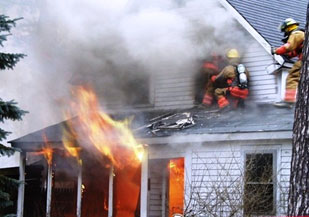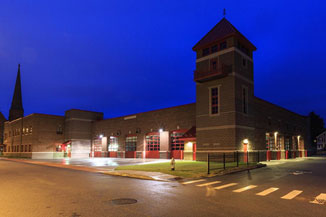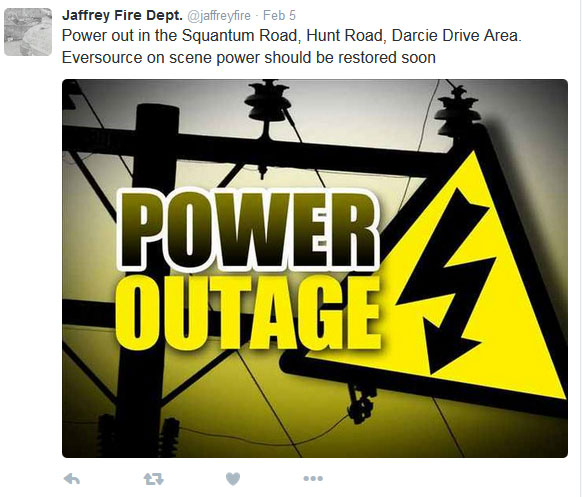
By William Greenwood
When a fire department acquires the funding to build a new fire station, it requires many people doing a lot of hard work to produce the best product for our taxpayers. That said, the building itself adds value to our community. The physical structure will not only house our emergency apparatus, but will also provide a place to shelter many well-trained responders who will stand at the ready for decades.

Photo by Deputy Chief Tom Redin, Southwestern New Hampshire District Fire Mutual Aid
When the fire department invests in our personnel, whether a basic firefighter course or a specialized technical rescue program, this investment also adds value, not only to the firefighter’s knowledge base but also to the organization. This education and experience will better prepare the department for future emergency responses. That training, whether a seminar or a full certification program, is significant and will benefit many lives over the life of the responder. Fire chiefs should acknowledge their accomplishment and ensure the responder’s commitment to complete the program is appreciated. This could be as simple as a public handshake, a verbal congratulations, or an official memorandum addressed to the entire fire department.


Above photos by author
Motivating some firefighters to take a class can be challenging, especially those adult learners who have been out of the classroom for a while. It truly takes an honest effort on behalf of the line officer to build a bond with his or her personnel. This bond will instill confidence that a member has the ability to take on the mental and/or physical challenges to complete a training program. Building confidence and trust is the most basic form of leadership, but the decision to make an investment in our members needs to be an ongoing process. Motivation requires not only verbal communication but ongoing support as well.
Providing the tools and equipment for success can be as simple as assisting with behavioral modification. When a leader sits down and provides his or her time, this can be the greatest gift of leadership. A true leader understands that his or her time will make the difference in building these relationships. The strongest of bonds are represented by those who have each other’s back. This investment into “building relationships” also adds value, which members will see as important and will drive engagement as well. The “engagement factor” is what we like to say drives a fire department’s ability to retain members.
When a fire department has the opportunity to prove their worth during an incident, it builds confidence and trust from their supporters. How we handle ourselves during adversity says a lot about the organization. When carefully pieced together, little by little and over many years, these building blocks result in community trust. Again, this trust adds value to the department and the community. Great leaders will tell you that the value obtained from their community is priceless. Many departments that are struggling to maintain a strong level of readiness–be it from lack of volunteerism or acquisition of tools and equipment–are often missing the support of their community. Community support and trust is hard to put a monetary value on it. Back in the earlier days, many fire departments felt they had the support of their community. The ability to maintain a connection was simpler. We all offered public education, fire prevention tours, fire department open houses, department inspections, and community breakfasts or dinners, and it was a fairly easy way to educate our citizens regarding our value and necessity in the community.
RELATED
Social Media: The Rules Are Already on the Books
Fire Service Leadership in a World of Technology and Social Media
The Fire Service and Social Media : Time to Get Engaged
Social Media Concerns During Emergencies and Incidents: Lessons from a Recent Tragedy
Given today’s fast-paced lifestyle is, how do we maintain this connection with our community supporters? As a service, we have proven to many our ability to remain progressive in terms of training and operational readiness with regard to changes in our scope of practice. These changes have been driven by the complexity of the world, necessitating preparedness for emergencies as diverse as weapons of mass destruction, bioterrorism, or even medical pandemics such as Ebola.
Digital Times
The fire service needs to look at new ways to connect with our taxpayers in this “fast-paced” lifestyle. For many, we have seen the attendance to our standard open house or pancake breakfast dwindle. The answer may be to look at digital methods of providing alerts to the public during disasters as well as disseminating regular and important information that will build trust and confidence in the 21st Century.
Without the ability to tap into the digital market, we the fire service will eventually alienate ourselves from the next couple of generations of financial supporters. When you look into ways to market your department into the next century, much of what we need is already at our fingertips. The cost for market share in these social media groups is minimal, often free. The biggest challenge a fire chief has is making sure we have protocols in place for the who, what, and where. The release of departmental information, regardless of the medium must have policies and parameters. The biggest reason many fire service leaders throw up a “protective wall” towards the use of social media is a lack of understanding. Leadership that is not comfortable with the “digital technology” is destined to fail. Whether a fire chief types his or her press release on a typewriter and sends it to the local news paper or types it in an e-mail, there is really no difference in the basic content or material. The major difference though, is the department’s ability (or inability) to tap into digital media.
In the past, the consumer reading a local newspaper or watching the evening news was actually getting information that was old. This information would be so outdated that the consumer of today refuses to accept it. That is why news stations today are in a race to beat their competition with a report of a news story. Once an event is deemed newsworthy, the attention turns to 24-7 live reporting with on scene satellite trucks. The reason why every news network has the ability to go live from anywhere in the world is because the consumer demands it. Nobody wants to read old news. In general, the average person is connected to real-time informational releases. A fire department that is not willing to meet the demand of their community with real-time informational dissemination will lose supporters.
While traveling around to teach, I have had the luxury of working with some really progressive fire departments. When I say that, I don’t just mean full-time, highly staffed organizations. Many of the departments I see tapping into technology are volunteer fire organizations. I have seen many great policies on informational dissemination and fire chiefs who understand the importance of engaging his or her “techie” member. These members are the go-to guys who understand the digital landscape.Where I am from, it is not unheard of to see a real-time “tweet” from the scene of a motor vehicle accident informing the community of traffic delays or road closures, and even safety concerns for incidents like live wires down.

One example of the benefit of 140-character “Tweets” from the Twitter service is the ability to provide a quick, 30-second informational blast to a group of followers that can benefit their busy lives. At one recent multiple-alarm fire, a fire department was able to announce the fire and warned their community members about potential traffic delays and that fire apparatus would be traveling to a specific area for a rural water supply tanker shuttle. This ability to communicate in real-time has provided the department with the means to inform their supporters with little monetary or time investment!
When the incident is mitigated, they will announce that the area is back to normal travel patterns.

Using the above fire as an example, the fire chief released a quick “tweet” announcing, “Smoke Alarms Alerts An Occupant.” This simple and easy “tweet” to their group of Twitter and Facebook followers yielded many good follow-up comments from the public. Many were thankful that the occupant was able to escape uninjured (a great selling point for working smoke detectors) and many supporters thanked the fire department for their quick and professional response. Instant feedback from the user system!
The basic core content or informational release is nothing new for the fire service. What is new is how to tap into the modern day market. Facebook and Instagram offers the fire department the ability to officially release photographs and/or press releases to their followers, as well.
The ability to quickly create and release information about public education demos, company and departmental training, or new certifications has never been easier. This medium allows the end user to not only read about the information but see it in a digital photograph or video. Fire chiefs who have had success with this format are also seeing an uptick in the recruitment of the XBox Generation. Members of this generation are not reading the local newspaper, and they despise email as it is seen as slow. What they are plugged into is “real-time messaging” and the ability to have short communications on the go. If your print shop poster or newspaper campaign is not bringing in new members from your last volunteer drive, maybe it is time to rethink your department’s public image and marketing.
Digital Downfall
We have all seen “rogue” releases of incident information due to the advent of the cell phone camera or even the high-quality helmet camera. And we have all seen the fire chief’s first instinct to ban or prohibit the use of this technology. Why? It is no different than the Polaroid or disposable camera of yesteryear.What has changed is the end users’ ability to access information. This is where the leadership of the department must establish clear and concise policies on the “who, what, and where” of information, and how it can be released.
The greatest asset we have in the firehouse is our personnel. Without them we would have a very difficult time to remain in existence. We must engage them by empowering them. The benefit of tapping into our internal resources not only instills confidence, motivation, and trust in the member, but will ultimately provide a new medium to provide a direct and positive connection with our community.
But be forewarned my friends, leadership is about the people business. Leading people into the future by providing them with the tools and equipment needed while guiding them towards a common goal. Having the membership follow the same trends, patterns, and behavior (“that’s how we’ve always done it”) is not preparing the organization for the future. The time has come for our leaders to lead and for the membership to step up and move our organizations into the foreseeable “digital” future.
 WILLIAM GREENWOOD has 20 years of experience in volunteer, paid-call, and career fire departments throughout New Hampshire. He is the training chief for the Manchester-Boston Regional Airport Fire Department and a lieutenant with the Keene (NH) Fire Department. He is a senior staff instructor with the New Hampshire Fire Academy. He is a pro-board certified National Fire Protection Association 1041 fire instructor III, 1021 fire officer II, firefighter III, and firefighter safety/survival instructor. He has been published in Fire Engineering and hosts “Tap the Box” on Fire Engineering Talk Radio.
WILLIAM GREENWOOD has 20 years of experience in volunteer, paid-call, and career fire departments throughout New Hampshire. He is the training chief for the Manchester-Boston Regional Airport Fire Department and a lieutenant with the Keene (NH) Fire Department. He is a senior staff instructor with the New Hampshire Fire Academy. He is a pro-board certified National Fire Protection Association 1041 fire instructor III, 1021 fire officer II, firefighter III, and firefighter safety/survival instructor. He has been published in Fire Engineering and hosts “Tap the Box” on Fire Engineering Talk Radio.


